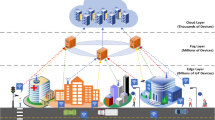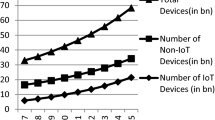Abstract
The communication industry is rapidly growing with the passage of time and the number of communication devices is increasing. This increase of communication devices put the devices and their communication into a high risk and security challenges. Intruders tries for capturing important information from such communication devices and are using for their own benefits. To build an effective and accurate decision support system (DSS) for the convergence of Artificial Intelligence (AI) and Internet of Things (IoT) can secure the systems for secure and smooth point-to-point communication. Multi-criteria decision support systems play an important role in decision making for a particular situation based on several security criteria. Decision making based on multi-criteria is one of the exciting issues faced by practitioners and researchers for the convergence of AI and IoT. Numerous DSS are available for making decisions which have the possibility to adopt activities of the decision making. The planned study presented a DSS for the secure convergence of AI and IoT for devices. The experimental work of the proposed study was carried out in the SuperDecisions tool for plotting the hierarchy of security situations based on goal, security criteria, and alternatives.









Similar content being viewed by others
Change history
10 May 2021
A Correction to this paper has been published: https://doi.org/10.1007/s11042-021-10975-0
References
Amanullah MA, Habeeb RAA, Nasaruddin FH, Gani A, Ahmed E, Mohamednainar AS, Mdakim N, Imran M (2020) Deep learning and big data technologies for IoT security. Comput Commun 151:495–517
Amin R, Nazir S, García-Magariño I (2020) A collocation method for numerical solution of nonlinear delay integro-differential equations for wireless sensor network and Internet of Things. Sensors 20:1962
Awotunde J, Ameen A, Oladipo I, Tomori A, Abdulraheem M (2016) Evaluation of four encryption algorithms for viability, reliability and performance estimation. Niger J Technol Dev 13:74–82
Chaitra B, Kumar V, Shatharama R (2017) A survey on various lightweight cryptographic algorithms on FPGA. IOSR J Electron Commun Eng 12:45–59
Cheah M, Shaikh SA, Haas O, Ruddle A (2017) Towards a systematic security evaluation of the automotive Bluetooth interface. Veh Commun 9:8–18
Cherdantseva Y, Hilton J, Rana O, Ivins W (2016) A multifaceted evaluation of the reference model of information assurance & security. Comput Secur 63:45–66
Dhanda SS, Singh B, Jindal P (2020) Lightweight cryptography: a solution to secure IoT” Wirel Pers Commun :1–34
Dimitrioglou N, Kardaras D, Barbounaki S (2017) Multicriteria evaluation of the Internet of Things potential in health care: The case of dementia care. In: (2017) IEEE 19th Conference on Business Informatics (CBI), pp 454–462
Drake JI, De Hart JCT, Monleón C, Toro W, Valentim J (2017) Utilization of multiple-criteria decision analysis (MCDA) to support healthcare decision-making FIFARMA, 2016. J Market Access Health Policy 5:1360545
Eisenbarth T, Kumar S, Paar C, Poschmann A, Uhsadel L (2007) A survey of lightweight-cryptography implementations. IEEE Des Test Comput 24:522–533
Fernandes JACS. Choosing the Future of Lightweight Encryption Algorithms [Thesis]. Available: https://fenix.tecnico.ulisboa.pt/downloadFile/281870113704550/Extended_Abstract-Choosing_the_Future_of_Lightweight_Encryption_Algorithms.pdf
Figueroa-Hernandez J Jr (2019) A comparison of lightweight Ciphers Meeting NIST lightweight cryptography requirements to the advanced encryption standard. California State Polytechnic University, Pomona
Frazão TD, Camilo DG, Cabral EL, Souza RP (2018) Multicriteria decision analysis (MCDA) in health care: a systematic review of the main characteristics and methodological steps. BMC Med Inf Decis Mak 18:90
Girija PMM, Ramaswami M (2019) Comprehensive Analysis on lightweight cryptographic algorithms for low resource devices. Test Eng Manag 81:14
Goyal TK, Sahula V, Kumawat D (2019) Energy efficient lightweight cryptography algorithms for IoT devices. IETE J Res :1–14
Gu Z, Nazir S, Hong C, Khan S (2020) Convolution neural network based higher accurate intrusion identification system for the network security and communication. Secur Commun Netw
Halabi T, Bellaiche M (2017) Towards quantification and evaluation of security of Cloud Service Providers. J Inf Secur Appl 33:55–65
Huang X, Nazir S (2020) Evaluating Security of Internet of Medical Things using the Analytic Network Process methods. Secur Commun Netw
Jouini M, Rabai LBA, Khedri R (2015) A multidimensional approach towards a quantitative assessment of security threats. In: Procedia Computer Science The 6th International Conference on Ambient Systems, Networks and Technologies, pp 507–514
Kerckhof S, Durvaux F, Hocquet C, Bol D, Standaert F-X (2012) Towards green cryptography: a comparison of lightweight ciphers from the energy viewpoint. In: International Workshop on Cryptographic Hardware and Embedded Systems, pp 390–407
Khan S, Ali H, Ullah Z, Minallah N, Maqsood S, Hafeez A (2018) KNN and ANN-based recognition of handwritten Pashto letters using zoning features. Int J Adv Comput Sci Appl 9:570–577
Li M, Nazir S, Khan HU, Shahzad S, Amin R (2020) Modelling features-based birthmarks for security of end-to-end communication system. Secur Commun Netw 2020:1-10
Mao W, Cai Z, Towsley D, Feng Q, Guan X (2017) Security importance assessment for system objects and malware detection. Comput Secur 68:47–68
Marwan M, Kartit A, Ouahmane H (2018) Security enhancement in healthcare cloud using machine learning. Procedia Comput Sci 127:388–397
Mohanta BK, Jena D, Satapathy U, Patnaik S (2020) Survey on IoT security: Challenges and solution using machine learning, artificial intelligence and blockchain technology. Internet of Things, vol 11
Mohd NAB, Zaaba ZF (2019) A Review of usability and security evaluation model of ecommerce website. In: The Fifth Information Systems International Conference 2019, pp 1199–1205
Mollaie F, Alizadeh M, Dadsetan S, Rashno A (2013) Implementation and evaluation of lightweight encryption algorithms suitable for RFID. J Next Gener Inf Technol 4:65–77
Nabeeh NA, Abdel-Basset M, El-Ghareeb HA, Aboelfetouh A (2019) “Neutrosophic multi-criteria decision making approach for iot-based enterprises. IEEE Access 7:59559–59574
Nazir S, Shahzad S, Nazir M, Rehman HU (2013) Evaluating security of software components using analytic network process. In: 11th International Conference on Frontiers of Information Technology (FIT), IEEE, Islamabad, pp 183–188
Nazir S, Shahzad S, Mahfooz S, Jan MN (2015) Fuzzy logic based decision support system for component security evaluation. Int Arab J Inf Technol 15:1–9
Nazir S, Ali Y, Ullah N, García-Magariño I (2019) Internet of Things for healthcare using affects of mobile computing: a systematic literature review. Wirel Commun Mob Comput
Patil P, Narayankar P, Narayan D, Meena SM (2016) A comprehensive evaluation of cryptographic algorithms: DES, 3DES, AES, RSA and Blowfish. Procedia Comput Sci 78:617–624
Pei C, Xiao Y, Liang W, Han X (2018) Trade-off of security and performance of lightweight block ciphers in Industrial Wireless Sensor Networks. EURASIP J Wirel Commun Netw 2018:117
Rahman HU, Rehman AU, Nazir S, Rehman IU, Uddin N (2019) Privacy and security—Limits of personal information to minimize loss of privacy. In: Future of Information and Communication Conference, pp 964–974
Rajesh S, Paul V, Menon VG, Khosravi MR (2019) A secure and efficient lightweight symmetric encryption scheme for transfer of text files between embedded IoT devices. Symmetry 11:293
Rana S, Hossain S, Shoun HI, Kashem MA (2018) An effective lightweight cryptographic algorithm to secure resource-constrained devices. Spectrum 9
Rani SS, Alzubi JA, Lakshmanaprabu S, Gupta D, Manikandan R (2019) Optimal users based secure data transmission on the internet of healthcare things (IoHT) with lightweight block ciphers. Multimedia Tools and Applications 1–20.
Saranya T, Sridevi S, Deisy C, Ducchung T, Ahamedkhan MKA (2020) Performance analysis of machine learning algorithms in intrusion detection system: a review. Procedia Comput Sci 171:1251–1260
Singh P, Deshpande K (2018) Performance evaluation of cryptographic ciphers on IoT devices. arXiv preprint arXiv:1812.02220
Song HH (2020) Testing and evaluation system for cloud computing information security products. In: 3rd International Conference on Mechatronics and Intelligent Robotics (ICMIR-2019), pp 84–87
Subsorn P, Limwiriyakul S (2012) A comparative analysis of internet banking security in Thailand: A customer perspective. Procedia Eng 32:260–272
Wang X, Li J, Kuang X, Tanc Y-A, Li J (2019) The security of machine learning in an adversarial setting: A survey. J Parallel Distrib Comput 130:12–23
Wang L, Ali Y, Nazir S, Niazi M (2020) ISA evaluation framework for security of Internet of Health Things system using AHP-TOPSIS methods. IEEE Access 8:152316–152332
Wijayarathna C, Arachchilage NAG (2019) Using cognitive dimensions to evaluate the usability of security APIs: An empirical investigation. Inf Softw Technol 115:5–19
Wu X, Liu S, Sun Y, An Y, Dong S, Liu G (2019) Ecological security evaluation based on entropy matter-element model: A case study of Kunming city, southwest China. Ecol Ind 102:469–478
Yuan J, Luo X (2019) Regional energy security performance evaluation in China using MTGS and SPA-TOPSIS. Sci Total Environ :1–11
Zhang Z, Wen J, Wang X, Zhao C (2017) A novel crowd evaluation method for security and trustworthiness of online social networks platforms based on signaling theory. Journal of computational science 26:468–477
Zhang J, Nazir S, Huang A, Alharbi A (2020) Multicriteria decision and machine learning algorithms for component security evaluation: library-based overview. Secur Commun Netw
Author information
Authors and Affiliations
Corresponding authors
Ethics declarations
Conflict of interest
The authors declared no conflict of interest regarding the publication of this paper.
Additional information
Publisher’s note
Springer Nature remains neutral with regard to jurisdictional claims in published maps and institutional affiliations.
The original online version of this article was revised: The author Lin Shi was left out as one of the corresponding authors.
Rights and permissions
About this article
Cite this article
Shi, L., Nazir, S., Chen, L. et al. Secure convergence of artificial intelligence and internet of things for cryptographic cipher- a decision support system. Multimed Tools Appl 80, 31451–31463 (2021). https://doi.org/10.1007/s11042-020-10489-1
Received:
Revised:
Accepted:
Published:
Issue Date:
DOI: https://doi.org/10.1007/s11042-020-10489-1




